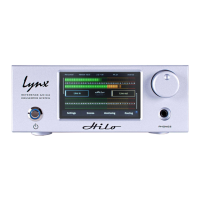
Do you have a question about the Lynx hilo and is the answer not in the manual?
| USB | USB 2.0 |
|---|---|
| Converter Type | AD/DA |
| Sample Rate | 44.1kHz to 192kHz |
| Analog Inputs | 2 x XLR |
| Analog Outputs | 2 x XLR |
| Digital Inputs | AES/EBU, S/PDIF |
| Digital Outputs | AES/EBU, S/PDIF |
| Word Clock | In and Out |
| Supported Data Rates | 44.1kHz to 192kHz |
Provides a general overview of Hilo's capabilities and design.
Details the comprehensive features of the Hilo converter.
Lists the contents of the Hilo package.
Covers power requirements and essential safety precautions.
Explains options for mounting Hilo in a rack.
Specifies compatible audio equipment for Hilo operation.
Lists system requirements for connecting Hilo to a computer.
Steps for unpacking the Hilo and verifying contents.
Guidance on placing and setting up the Hilo device.
Details connecting Hilo to a computer via USB.
Explains connecting line-level analog audio sources via XLR.
Explains connecting line-level analog audio destinations via XLR.
Details connecting monitor outputs using ¼" cables.
Describes connecting AES/EBU digital audio via XLR.
Instructions for connecting S/PDIF or ADAT via TOSLINK.
Details connecting S/PDIF via coaxial RCA.
Explains connecting word clock signals via BNC.
Information on connecting an external battery pack.
Instructions for connecting the AC power cord.
Guide to installing Hilo USB drivers on Windows.
Explains how Hilo interacts with Windows audio systems.
Using Hilo with macOS audio applications.
Adjusting buffer sizes for latency in macOS.
Instructions for unpacking the Hilo-TB and checking contents.
Guidance on the initial physical setup of the Hilo-TB.
Details connecting Hilo-TB via Thunderbolt cables.
Explains connecting line-level analog audio sources via XLR.
Explains connecting line-level analog audio destinations via XLR.
Details connecting monitor outputs using ¼" cables.
Describes connecting AES/EBU digital audio via XLR.
Instructions for connecting S/PDIF or ADAT via TOSLINK.
Details connecting S/PDIF via coaxial RCA.
Explains connecting word clock signals via BNC.
Guide to installing Hilo Thunderbolt drivers on Windows.
Using Hilo with Windows multimedia applications.
Using Hilo with ASIO-compatible audio applications.
Using Hilo with macOS audio applications.
Adjusting buffer sizes for latency in macOS.
Instructions for unpacking the Hilo-Dante and checking contents.
Guidance on the initial physical setup of the Hilo-Dante.
Details connecting Hilo-Dante via Ethernet cable.
Explains connecting line-level analog audio sources via XLR.
Explains connecting line-level analog audio destinations via XLR.
Details connecting monitor outputs using ¼" cables.
Describes connecting AES/EBU digital audio via XLR.
Instructions for connecting S/PDIF or ADAT via TOSLINK.
Details connecting S/PDIF via coaxial RCA.
Explains connecting word clock signals via BNC.
Setting up a computer for Dante network integration.
Using Dante Controller for routing and configuration.
Initial power-up sequence and touchscreen calibration.
Adjusting headphone and monitor output levels.
Explains the conventions used in Hilo's menu screens.
Detailed look at each meter screen type.
Description of the Analog VU meter display.
Audio configuration settings for Hilo.
Setting and displaying the Hilo's sample rate.
Setting and displaying the Hilo's sync source.
Adjusting Hilo's display backlight settings.
Using pre-configured scene settings.
Default scene routing audio to all outputs.
Scene routing play devices to unique outputs.
Scene for standalone AD/DA conversion without computer.
Scene for mastering engineers with specific routing.
Creating and saving custom scene configurations.
Overview of the monitoring page interface and controls.
Step-by-step example of using the routing page.
Procedure for updating LT-USB card firmware.
Installing and launching Hilo Remote for USB connection.
Installing and launching Hilo Remote for Thunderbolt.
Installing and launching Hilo Remote for Dante connection.
Downloading and using Hilo Remote on an iPad.
Explains the functions in the Hilo Remote navigation bar.
Resources for Hilo support on the Lynx website.
Provides telephone support contact information.
Instructions for registering the Hilo product.
Details the policy for returning a defective Hilo unit.
Explains different ways to connect the Hilo.
Connecting Hilo via USB 2.0.
Connecting Hilo via Thunderbolt.
Connecting Hilo to a Dante network.
Connecting Hilo to ProTools systems.
Using Hilo as a standalone device.
Information on powering Hilo with a DC battery pack.
Wiring details for balanced XLR to TRS connections.
Wiring for unbalanced XLR to ¼" phone connections.
Answers to common Hilo operational questions and issues.
FCC compliance statement for Hilo.